- More More
- Blog
- Inspire me
- Groups
- Offers More
- Dive Courses More
- Liveaboards
More

Liveaboard Trips
On-board accommodation offering the opportunity to live right over the dive sites and to experience secluded dives...
Diving regions...
- LATEST AVAILABILITY BY REGION
- Red Sea availability
- Maldives availability
- Indonesian availability
- Socorro Mexico availability
- Galapagos availability
- ALL LIVEABOARD DIVING REGIONS
- Bahamas
- Bikini Atoll
- Caribbean
- Cocos Island
- Destinations
MoreDIVING REGIONS...
Our Top destinations....Why not try....
Find a trip
- Resort
- Liveaboard
5 reasons to visit Malta
16 May 2019
1) Malta offers some of the best diving in the Mediterranean, and there are plenty of topside activities for non-diving partners too. There are wrecks and stunning underwater seascapes to explore for experienced and technical divers, but Malta also makes an ideal location for learner divers and those wanting to - all of this just a short flight away from the UK.
2) Malta’s underwater topography is stunning – there are caves and caverns to explore, but it’s the island’s extraordinary number of wrecks that attracts many divers. Malta’s strategic location in the Mediterranean Sea has made it the focus for many ruling powers throughout history and it is, in part, this legacy which has led to dozens of shipwrecks around its shores.
3) Warm water and excellent visibility mean that whether you’re exploring wrecks on a technical dive, or taking your first steps underwater as a learner diver, Malta makes a great dive destination.
4) Gozo – a dive holiday in Malta can easily be combined with a stay on the neighbouring island of Gozo. With 44km of coastline, and 50 dive sites to explore off Gozo and the tiny island of Comino, plus submarine arches, tunnels and caves to navigate, Gozo makes an excellent addition to any Malta dive holiday.
5) Plenty of topside interest on Malta and Gozo – Malta’s capital, Valletta, is a World Heritage Site and historic highlights include the Grand Master’s Palace and St John’s Cathedral, plus winding medieval streets and attractive squares. There’s also a great choice of restaurants, bars and cafés. With lovely beaches and coves, plus a network of walking and cycling trails to enjoy, it’s worth spending some time exploring on land as well as under the water. If you can extend your holiday to include time on the unspoilt neighbouring island of Gozo, fishing villages, a hilltop citadel and a wonderfully relaxed pace of life await.
For more information, or to plan your diving holiday to Malta and Gozo, speak to the Regaldive team on 01353 659999 or send us an email!
Find a trip
- Resort
- Liveaboard
Unexpected delights in the Red Sea
3 May 2019
I was picked up in the morning from my hotel, the impeccable Sunrise Marina Resort in Port Ghalib, and a few minutes later was welcomed at the Emperor Divers dive centre on the far side of the marina. As this was a work trip rather than a diving trip, I hadn’t brought my dive gear. The Emperor team quickly and efficiently got me kitted out with excellent quality rental gear however, and we were on our way,
One thing that came flooding back to me as we ventured out onto the Red Sea was the colour of the water. I’ve been fortunate to dive many places, and there is nowhere else I’ve been where the colour of the water is quite the same majestic hue of turquoise. It brought a smile to my face before I’d even entered the water.
Many moons ago, when youth was on my side, I spent a season as the videographer for Emperor in Sharm el Sheikh, careering around underwater getting shots of the clients, their experiences, and the marine life they saw. This was my first opportunity both to dive the southern Red Sea, and also to be an Emperor customer. I must say both were a privilege.
With the chance for only one day’s diving on this trip, I was not expecting too much in terms of marine life encounters. The fact I was diving in early January, one of the cooler and quieter months in this area, also added to my relatively low expectations. How wrong I was.
We dropped in on our first dive and ambled along a fairly quiet patch of reef. This gave me a few welcome moments to get settled underwater and to get my bearings. We then came across a wonderful pinnacle dripping in life and colour. Healthy soft corals reached out into the blue to catch the current, and a vibrant community of marine life called the pinnacle home. As is common in the Red Sea, the picture was made perfect by the carpet of fluttering orange adoring the reef, as anthias constantly jostled for position. There are few places in the world with the kaleidoscopic colours of the Red Sea, and we are so fortunate to have it almost on our doorstep.
As we crossed from the first pinnacle to another, the dive just got better. First, a green turtle of impressive size swam serenely past, almost oblivious to the group of divers admiring her beauty and grace. Shortly after, a small school of five or six eagle rays glided past to add to the sense of glee. These were smaller eagle rays, not the juveniles sometimes found in sheltered bays, but not adults either; possibly young teenagers, making their way in the world. Another gorgeous pinnacle ended a perfect first dive.
I’d have been more than happy with my lot from just that dive. It was well worth the chill that greets recently surfaced divers at this time of year as they struggle, unglamorous, out of their neoprene. The surface interval brought more delights, and a first for me. This area of the Red Sea is known for a small population of rare dugongs. These unusual animals, who some attribute to the legend of mermaids, spend their days munching on the plentiful seagrass. The dugong is rather unlike any other animal bar their close cousin, the manatee; and they had been on my wishlist for many years. The chance to see one while snorkelling, however fleetingly, added to the magic of my morning.
A second dive brought more turtle encounters, bringing an end to a perfect day, and one that I’ll cherish for many years to come. My thanks go to Seamus, Paul, Hamada, and the entire Emperor team in Port Ghalib for such a fantastic day.
Emperor Divers are one of the longest running and most experienced dive operators in the Red Sea. They have gained a well-deserved reputation for both professionalism and excellent customer service. Based in the Marina Lodge in Port Ghalib, a short distance from Marsa Alam airport, Emperor Divers made the ideal base to explore the diving in this area.
If you’d like to discover the underwater treasures of Marsa Alam for yourself, contact Regaldive for a quotation.
Emperor Divers operate another dive centre in El Gouna, along with a number of liveaboards as well. Contact our friendly team on 01353 659999 for full details of the diving opportunities on offer with Regaldive and Emperor Divers
Find a trip
- Resort
- Liveaboard
Diving Holidays with Kids
17 Apr 2019
Plenty of hotels offer kids' clubs and activities to keep little ones entertained, or for young divers a summer holiday is the perfect time to take those first few breaths underwater! Take a look at our Junior Diving Courses for more information…
The Red Sea is the perfect destination for families looking for great value sunshine and diving outside of Europe, but without a long-haul flight. With excellent facilities, child-friendly resorts and topside activities, the Red Sea is a great destination to consider if you're looking for an easy, stress-free family holiday this summer.
Concorde Moreen Beach Resort With a good selection of family rooms, a kids' club and two child-friendly pools, this resort also enjoys views over the 800m white sandy beach and a brilliant house reef. Learn to dive in the calm bays of Marsa Alam, or venture further to enjoy the stunning reefs and marine life of the Southern Red Sea.
Sunrise Marina Resort Port Ghalib This resort’s kids' club, games rooms and colourful assortment of water slides make it an ideal choice for families. The resort also features its own exclusive private sandy beach and coral caves, a conveniently located dive centre and easy access to the exciting Southern Red Sea and its myriad pristine reefs.
Movenpick Hotel The Movenpick has two children's pools, a play area, children's menu and kid's club, along with family and inter-connecting rooms. El Gouna is a superb place to learn to dive with access to many spectacular coral gardens in sheltered waters, while the best of the Northern Red Sea is in easy reach for more advanced wreck diving.
Malta is another destination perfect for families. In the Mediterranean sea, Malta is only a short flight from the UK and with self-catering accommodation options, such as Sands Apartments and Villa Michael, family holidays to Malta are very affordable!
The Maltese islands are also the perfect place to introduce your little ones to diving, with calm warm seas (especially nearer the end of the summer) and excellent visibility.
Bonaire is perfect for divers and snorkellers of all abilities and great diving destination year-round. The superb training facilities, the lack of currents and clear waters make Bonaire perfect for younger divers to learn, while experienced divers can enjoy the freedom of unlimited access to diving, day or night. Stay at the family-friendly Buddy Dive Resort, and make the most of their range of kids' clubs, introducing kids over 5yrs to the underwater world!
For a personalised family quote or more family holiday options, speak to the Regaldive team on 01353 659999.
Find a trip
- Resort
- Liveaboard
Reasons to dive the Red Sea
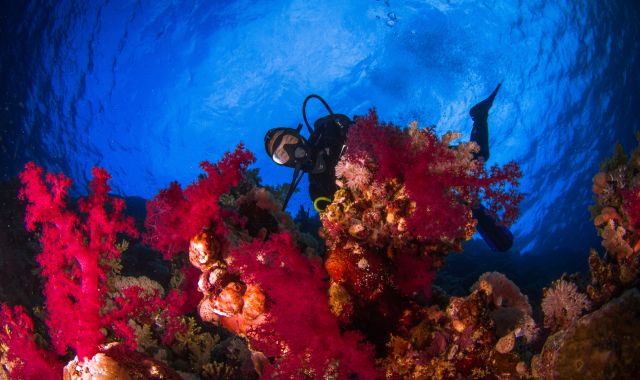
21 Feb 2019
But what’s so great about diving in the Red Sea?
The Climate
Discover the underwater world of the Red Sea year round, as water temperatures rarely fall below 22C even in the middle of winter and can reach highs of 30C in summer, while the air temperatures range from 20-40C year round.
The Water
The warm, clear waters of the Red Sea attract an incredible abundance of marine life with visibility reaching up to 40m making it perfect for underwater photographers or as a place to learn to dive.
The Reefs
With incredible biodiversity and beautiful bright colours, the reefs in the Red Sea are a wonderful reason to visit. More than 220 different species of hard and soft coral thrive here along with more than 1,100 fish species, of which almost a fifth can’t be found anywhere else on Earth. For the most spectacular reefs, head to Ras Mohammed National Park in the north (via liveaboard) or Fury Shoals from Hamata in the south.
The Wrecks
The northern Red Sea has multiple brilliant wrecks, the most famous being the iconic S.S. Thistlegorm (accessed by liveaboard). Four wrecks can be explored at Abu Nuhas from either a liveaboard or day boat from El Gouna. Many other wrecks are covered in stunning bright corals, full of interesting preserved artefacts or frequented by pelagic species.
The Marine Life
Egypt has it all, from large pelagics to tiny critters, a spectacular array of marine life for diving enthusiasts of all abilities. In the warmer summer months, the periodic plankton bloom attracts larger pelagic species including several species of shark, manta rays on the offshore reefs and the occasional whale shark sighting. Both bottlenose and spinner dolphins are regularly seen as are fevers of eagle rays and the iconic blue spotted ray. Expect to encounter green and hawksbill turtles, clownfish, lionfish, Napoleon wrasse and perhaps the elusive dugong. Large schools of fish can also arrive at various dive sites…
…all this and the Egyptian Red Sea is only a short 5hr flight from the UK!
At Regaldive we offer a choice of nine Egyptian Red Sea resorts and a comprehensive range of liveaboards. For help on deciding where to visit, speak to a member of our expert team on 01962 302087 or send us an email!
Find a trip
- Resort
- Liveaboard
The White Shark Café
5 Dec 2018
Guadalupe is a remote volcanic island that lies 150 miles off the west coast of Mexico’s Baja California peninsula. Home to the ocean’s most iconic and often misunderstood predator, this region of the Pacific Ocean is sometimes referred to as ‘White Shark Café’ and for good reason.
Accessible only by specialist and experienced liveaboard operators, between the months of July-November unforgettable encounters with these most captivating of animals are commonplace. Although the myth of the indiscriminate killer shark exists in the minds of many, it’s rare to find a scuba diver that still holds onto this outdated notion, and so trips that offer the opportunity to come nose to nose with the world’s largest macro-predatory fish attract divers from across the globe.
It’s true that white sharks do not seek out people as prey but it would still be ill-advised to splash around in these waters and so all activities take place safely behind bars. The Nautilus Fleet includes 3 purpose-built vessels, The Nautilus Belle Amie, The Nautilus Under Sea and The Nautilus Explorer, that operate in Guadalupe, each with two submersible cages that are lowered to a depth of 10m and hang from each side of the stern. Typically 3 submersible ‘dives’ using surface fed air are offered per day to certified divers only. Two surface cages are also available for divers and non-divers alike from 6 am- 6 pm and so a huge amount of time can be spent in the water to increase the likelihood of encounters.
During our trip in August, we saw sharks every time we jumped in the cage. Between July and September, it’s more common to see males and although typically smaller than females they can certainly reach an impressive size. We were lucky enough to share the water with a celebrity of the shark world, none other than ‘Big Bruce’. A confident and curious male close to 5m in length, Bruce is pretty much as big as a male Great White will get with some very rare exceptions. He has appeared on a number of documentaries and contributed to the scientific data that is collected and shared around the world, thanks to his electronic tag.
Awe-inspiring, captivating, intimidating…the White Sharks at Guadalupe are all of these things but they are also effortlessly graceful and unquestionably intelligent. Individual personalities were plain to see as some took time and patience to approach the cages whilst others were far more confident, even bold enough to give us the occasional nudge and bump.
For me, the thrill of diving is, for the most part, the sense of freedom it provides as I love the feeling of exploring an underwater world. Seeing Great Whites has always been on my ‘bucket list’ but in the weeks leading up to our trip I had some concerns that I might actually get bored or at the very least feel contained with ‘cage fever’…not a chance!
From the first sighting, every descent in the submersible cage was as thrilling as the last, filled with anticipation and excitement. It’s fair to say that I am hooked and have vowed to return; after all, it will always be a special place for us ever since I proposed to my girlfriend in the cage with Big Bruce cruising by!
Mat is an experienced Divemaster and travel consultant with an appetite for adventure. You’ll find him as close to the action as possible both above and below the waves; over the years Mat has been charged by a hippo, chased by a lion, stalked by a shark and stung by a Portuguese Man Of War!
To find out more about diving with Great White Sharks contact us on 01353 659999
Find a trip
- Resort
- Liveaboard
The Magical Maldives
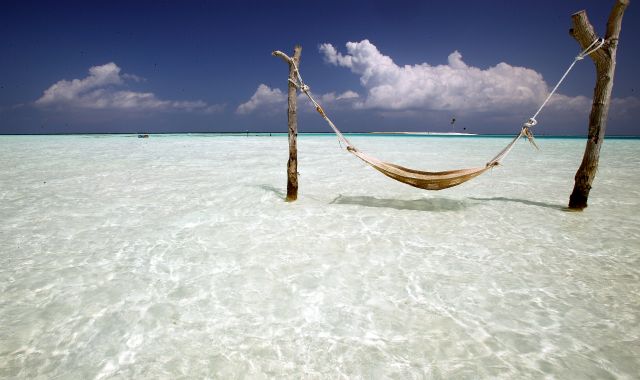
21 Aug 2018
One of our most popular diving destinations, the Maldives is a picture-postcard paradise. Stunningly beautiful white sand beaches complement the exhilarating underwater environment that offers some of the finest diving in the world.
Adrenaline-charged drift dives, an abundance of colourful coral critters and encounters with pelagics - mantas, whalesharks and other shark species - are the reason divers return to the Maldives time and time again.
The variety and diverse nature of dive sites makes the Maldives suitable for divers of all levels of experience. Within each atoll, there are sheltered reefs suitable for beginners, whilst experienced divers will enjoy some of the best drift diving in the world.
Joining a Maldives liveaboard gives you the opportunity to experience Maldives diving at its best. MY Amba was one of the first liveaboards to operate around the most northerly atolls, and offers some truly exploratory diving. Over the past thirty years, an incredible range of world class dive sites in the Maldives have been charted and explored in the atolls surrounding Male. We also offer liveaboards that cover exciting atolls in the far north and south of the Maldives. The diving would suit those looking to visit untouched sites in search of the unknown.
If you prefer to plant your feet on the sand after a day’s diving, then a Maldives resort would provide you with a true diving getaway in your own corner of paradise, giving you all the charm of an authentic Maldivian experience.
Regaldive offer a number of resorts to suit every preference, ranging from budget-friendly resorts where the focus is all about the diving, to exclusive resorts with plenty of island amenities to pamper you as well as provide a sublime diving experience.
Eriyadu is a relaxed and friendly island is surrounded by dazzling white beaches. It features a calm lagoon which is ideal for learning to dive, as well as offering plenty of more challenging dive sites for experienced divers. Vilamendhoo lies in the heart of some of the most thrilling dive sites in the Maldives. The island boasts an exceptional house reef that attracts both divers and snorkelers back year after year. The reef is beautifully formed with several shallow caves and overhangs. The island attracts many pelagic species as well as an abundance of marine life.
If you are thinking about a trip to the Maldives, but not sure if you would prefer a liveaboard or a resort, then please call us for a chat: we have the knowledge and expertise to provide you with your prefect trip to picture-postcard paradise.
Find a trip
- Resort
- Liveaboard
A Sensational Shark Season in the Red Sea
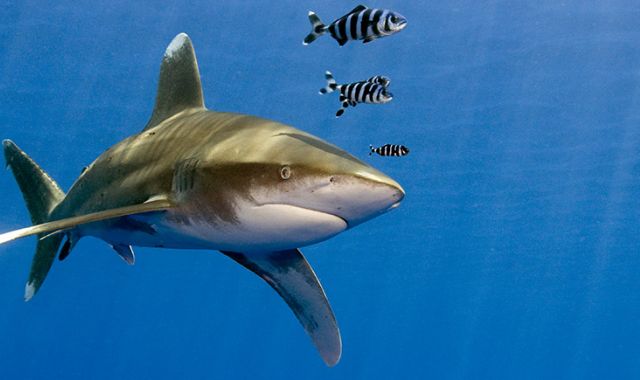
9 Aug 2018
We are receiving regular feedback from excited guests on Red Sea liveaboards and day-boats that shark sightings are on the increase. There have even been some very special visitors to a house reef in Safaga!
Shark season in the Red Sea traditionally runs from May to October, and during this time liveaboard operators focus on itineraries specifically created for divers looking to maximise their chances of diving with sharks. Favoured sites include The Brothers, Daedalus, Elphinstone, Fury Shoal and St. John’s Reef.
Hammerheads, silvertips, silkies, oceanic white tips and threshers are often spotted at The Brothers, and sightings of grey reef sharks are common on the North and South Plateaux of Small Brother. Elphinstone offers regular encounters with oceanic white tips, while Daedalus is famous for its schools of hammerheads. The more southerly sites of Fury Shoal and St. John’s Reef are famous for hammerheads, grey sharks, silvertips and white tip reef sharks.
We offer a number of trips that visit these legendary sites, flights are available from a number of UK airports.
Guests returning from many Red Sea resorts are also reporting an increase in shark sightings on their day-boat trips. Divers looking for a land-based holiday with the chance of getting up close and personal with sharks should head to El Quseir, Marsa Alam, Shams Alam or Hamata.
Finally, how about diving over a house reef and bumping into a whaleshark? This is exactly what could happen to you when diving on Coral Garden’s magnificent house reef in Safaga. Several whaleshark encounters have been reported by excited divers, with video footage eagerly being shared on social media.
For the best chance of diving with sharks in the Red Sea call us today to discuss your options. Whether you are looking for a liveaboard, day-boat or house reef, we can place you right in the middle of some sensational shark action!
Find a trip
- Resort
- Liveaboard
John’s Glorious Galapagos Getaway
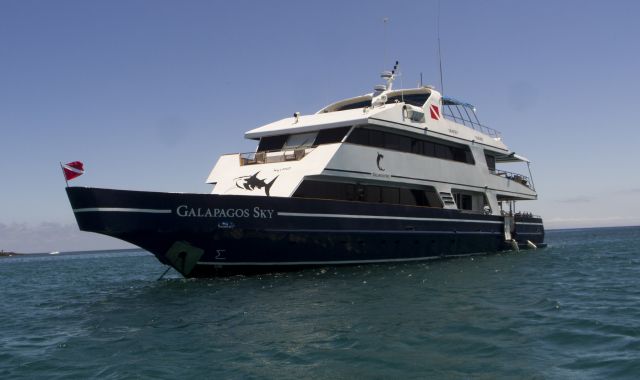
4 Jun 2018
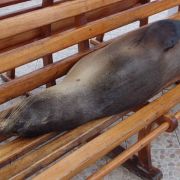 I'm sure most divers have a wish list; some might call it a bucket list. I'm also sure that many of those lists will include the iconic Galapagos Islands. I realised a long held ambition to visit there recently and had been excited about going since I booked it seven months earlier.
I'm sure most divers have a wish list; some might call it a bucket list. I'm also sure that many of those lists will include the iconic Galapagos Islands. I realised a long held ambition to visit there recently and had been excited about going since I booked it seven months earlier.
Of course, like many far-flung destinations, they take a bit of getting to: after a 14 hour international flight, I spent a couple of nights on mainland Ecuador before finally taking a flight out to the easterly island of San Cristobal where we would rendezvous with our accommodation for the week: the stunning Galapagos Sky. She is a lovely and comfortable boat, with service that is second to none. We were provided with excellent food and wine too.
Anyone who knows me knows that I am a bit of a wimp as far as water temperature is concerned, and many took great delight in warning me how cold the water would be in Galapagos. Because of this I chose my time carefully, going in May when the water is at its warmest. However, what I found most surprising was how much it varied between the different diving locations. The first day it was a reasonable 24 degrees, then up to a very pleasant 26, before plummeting to a just about bearable 20 degrees. If you are planning a Galapagos trip then it’s best to keep more layers of neoprene, gloves and hood in reserve.
After our first full day’s diving around Bartolome we had a lovely dinner, accompanied with a few glasses of wine, and eventually settled into our beds while Galapagos Sky motored up to what most divers consider to be the highlight of any Galapagos liveaboard trip: the islands of Wolf and Darwin.
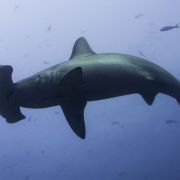 On our first day’s diving on Wolf we undertook three day dives and a night dive. Justifiably famous for their sharks, we weren't to be disappointed. It would be difficult to have counted the number of Hammerheads and Galapagos Sharks that we saw on the day dives, but certainly enough to keep any shark lover happy. On the second dive we got a special bonus; a Whale Shark passed us twice. This was particularly noteworthy, as May is generally considered to be low season for these majestic creatures.
On our first day’s diving on Wolf we undertook three day dives and a night dive. Justifiably famous for their sharks, we weren't to be disappointed. It would be difficult to have counted the number of Hammerheads and Galapagos Sharks that we saw on the day dives, but certainly enough to keep any shark lover happy. On the second dive we got a special bonus; a Whale Shark passed us twice. This was particularly noteworthy, as May is generally considered to be low season for these majestic creatures.
Another shorter, overnight passage took us up to the island of Darwin, and we awoke to a stunning view of the iconic Darwin's Arch. Often seen on Galapagos documentaries, it was amazing to finally see the real thing. On every dive there you head straight towards it in the RIB, are dropped quite close, and then it towers over you as you surface from the dive.
As with Wolf, the diving at Darwin is all about the big stuff, lots of Hammerhead, Galapagos Sharks and plenty of Green and Loggerhead Turtles too. That day’s bonus was a pod of Bottle-nosed dolphins that went overhead during the dive and then came nice and close as we were about to exit the water.
Needless to say, we hung about in the water with cameras at the ready for another 10 minutes. They also followed us back to Galapagos Sky, often leaping out of the water, to the delight of us all.
One of the aspects I love about being a diver is visiting amazing places that few people experience. That's certainly the case with Darwin, and we were the only boat present for the day and a half we spent there.
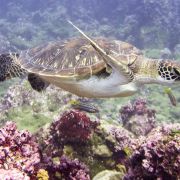 After five dives at Darwin we returned to Wolf for a further two dives, and this is probably where we had our best Hammerhead action during the whole trip. These dives involve quickly dropping down onto the sloping wall of the island, hanging on to the rocks for 20 to 30 minutes and just watch what goes by.
After five dives at Darwin we returned to Wolf for a further two dives, and this is probably where we had our best Hammerhead action during the whole trip. These dives involve quickly dropping down onto the sloping wall of the island, hanging on to the rocks for 20 to 30 minutes and just watch what goes by.
Luckily it's here that the water is at its warmest, so staying put did not mean getting cold. The number of Hammerheads seen on those two dives must have run into the hundreds, often passing by in a stream of 50 or so at a time. Certainly a sight I will never forget.
Sadly our time at these iconic islands had to come to an end and we returned to the main islands via the east side of Isabella. The water here was the coldest we encountered as it receives the colder currents from the south and west.
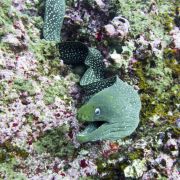 The attraction here was the famous Marine Iguanas, who sit on the rocks and warm up in the sun before they enter the water to feed. There must have been 30 or 40 on the surface as you take the RIB towards the shore, but they are actually a bit harder to spot underwater, although we got nice and close to three or four of them on one dive. There were plenty of turtles about in the area too.
The attraction here was the famous Marine Iguanas, who sit on the rocks and warm up in the sun before they enter the water to feed. There must have been 30 or 40 on the surface as you take the RIB towards the shore, but they are actually a bit harder to spot underwater, although we got nice and close to three or four of them on one dive. There were plenty of turtles about in the area too.
Our final afternoon consisted of a choice between two dives or one dive and a trip in the RIB to see Blue Footed Boobies and Penguins. I wanted to dive as much as possible, so chose two dives and was glad I did: I saw a small Bullhead Hornshark, which was a first for me. On both dives we were buzzed by inquisitive Sea Lions which certainly spiced up the safety stop.
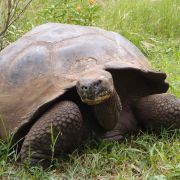 The final afternoon involved a land visit to the island of Santa Cruz, mainly to see the Giant Tortoises. A fun way to spend one’s time when not able to dive.
The final afternoon involved a land visit to the island of Santa Cruz, mainly to see the Giant Tortoises. A fun way to spend one’s time when not able to dive.
My trip to the Galapagos Islands was everything I had hoped for. I met some lovely people, saw some amazing animals and experienced a great boat where service is paramount. My first, but hopefully not my last trip to this iconic destination. I would certainly urge every diver to experience the Galapagos Islands at least once in their life.
Find a trip
- Resort
- Liveaboard
Dive the Iconic Sites of Sharm with Regaldive
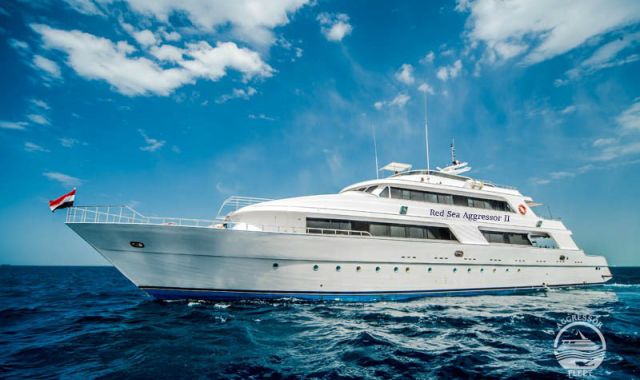
19 Apr 2018
We are delighted to announce the addition of the beautiful Red Sea Aggressor II to our liveaboard product range, enabling UK divers to once more experience the world-famous diving upon which Sharm built its reputation.
Operated by the acclaimed Aggressor Fleet, the Red Sea Aggressor II is a brand new luxury liveaboard providing the highest standards of quality and personal service. Itineraries run from Saturday to Saturday and depart from Hurghada.
Highlights include the world-famous wrecks of the Thistlegorm, Rosalie Moller and Abu Nuhas. Guests will also dive the legendary sites for which Sharm gained its reputation, including the Ras Mohamed National Park and Straits of Tiran, featuring the stunning reefs of Jackson, Woodhouse, Thomas and Gordon; known for their extraordinary diversity of coral and pelagics.
Our Director, Andreas Elia, said: “We are very excited to be able to bring this stunning new liveaboard into our Red Sea product range. With Sharm airport currently off limits for UK divers, this represents their best option to dive world famous sites that have been thrilling divers for decades. Due to the recent drop in divers visiting Sharm, the reefs are in excellent condition and there is an abundance of marine life. With the addition of the Red Sea Aggressor II we can offer our guests a truly memorable experience, which is already generating a huge amount of interest.”
Demand is high for the Red Sea Aggressor II, so If you want to experience the best diving in the Red Sea please call us now on 01353 659999.
Find a trip
- Resort
- Liveaboard
Tony’s Incredible Indonesian Adventure
12 Apr 2018
Regaldiver Tony G. recently returned from a marathon 77 day trip around Indonesia. On his adventures he visited three island groups, travelled 1,000s of miles and logged a whopping 133 dives. Phew! We are exhausted just thinking about it!
Tony started his adventure at the East Kalimantan, before moving on to the Manado in North Sulawesi, and finally Cape Paperu Dive Resort.
This is Tony’s amazing report…
"As this was to be my first visit to Indonesia, I was a little unsure as to what to expect. I had read about how good the diving can be, but thought that I should keep an open mind and just enjoy the adventure. As it happens I enjoyed every single dive that I made (133). There was always something different to see, from mantas and fast drift diving at Derawan Island to wall diving at Manado, muck diving at Lembeh to unspoilt coral gardens and fish life on Saparua Island.
The transfers and ground arrangements were excellent, though at first I thought them to be rather ambitious; 77 days; 3 island groups; 3 overnight hotels; 4 resorts; 6 ground transfers; 4 water transfers and 11 flights, something was bound to go wrong. In the end, apart from a 20 minute wait for a vehicle at Berau Airport, all transfers and ground arrangements went according to plan.
I like diving; just being in the water is a pleasure for me, and I can always find something of interest to look at. Because of the amount of time I spent at each resort it was inevitable that I would visit a dive site more than once, which in some ways was good because I knew where to spend time looking for things of interest.
I found all of the dive centre staff, and in fact all of the Indonesian people that I met and talked to, to be very helpful, cheerful, and it was a pleasure to be amongst them.
I have so many wonderful memories of my trip, but a particular highlight was one of the first drift dives that I made while staying on Derawan Island. At the dive site, after hooking on to the reef and floating off the bottom in the current, I was slowly engulfed in a huge school of Barracuda, so close I could have reached out and touched them. I was completely surrounded by them on either side, below and above me. The school was so dense that it was as though the sun had gone in and clouds had darkened the sky.
I was extremely happy with Regaldive; you answered all of my queries promptly and were most helpful in every way. I will certainly book with you again."
What an amazing experience it was for Tony, who is now back at home and planning another extended trip. If you would like Regaldive to organise your next adventure please call us on 01353 659999. Who knows where it could lead…




